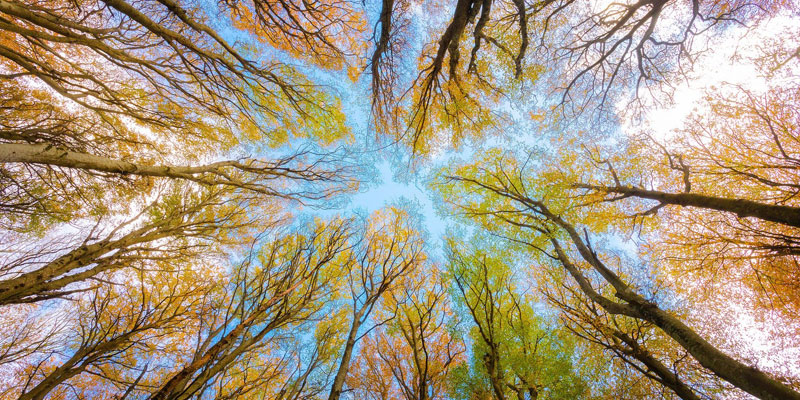Blog: Urban trees do more than capture carbon
Tree planting might seem like an easy answer to UK net zero efforts. But while the carbon capturing ability of trees is not in doubt, in this blog, Dr Alison Dyke argues that trees offer so much more to urban communities than photosynthesis.

As climate action becomes ever more urgent, tree planting has been seized upon as a means to visibly respond. Councils in the Glasgow area plan to plant 18 million trees alongside their hosting of COP26 this year, while the 74 per cent of local authorities that have declared a climate emergency often see trees as key to achieving a carbon balance.
A national UK tree planting target of 7,000 hectares per annum of new woodland is a central pillar in efforts to reach net zero by 2050. Without going into detail on the effectiveness of tree planting for carbon capture, while trees will sequester carbon as they grow, emissions are happening now and these newly planted trees may be too late to have significant impact. It is concerning that we have been some way off meeting anything like those targets in the last five years. There are many reasons for this, not least, that tree planting stock takes several years to grow, but there is a time lag also in decision making on where to plant those trees.
Ambitious targets
All of the hope that is attached to new tree planting is encouraging because these ambitious targets present an opportunity to realise other benefits from trees, and that says a lot about the strength of human relationships with trees. My hope for COP26 is that debates about the effectiveness of trees for carbon sequestration do not overshadow the other positive impacts that an increased focus on trees could have.
In urban areas, where human populations are concentrated, the benefits of trees have the potential to reach more people. Direct benefits such as provision of shade, countering air pollution, providing attractive places to spend relaxing time outdoors or to exercise are important in urban areas. The social and cultural values of trees are often mechanisms through which well-being benefits can be accrued, such as by providing a focus for connectedness to place or giving a sense of transcendence, of being part of something larger than yourself that puts your own life into perspective.
If trees are not accessible, though, neither are the benefits. A recent meta-analysis showed that lower socio economic groups across Europe consistently have poorer access to greenspace than those who are more well off.
Trees in deprived areas
Urban tree cover is surprisingly poorly understood, but if the distribution of greenspace is unequal, so too is the distribution of tree cover. In Wales, the most deprived urban wards are far more likely to have less than 10 per cent of canopy cover, as well as being less likely to have higher levels of canopy cover than less deprived neighbourhoods (See Table 1). Tree canopy cover targets for cities are rare, but where they do exist, they tend to be for 20-30 per cent of land area. By this measure, deprived wards are far less likely to be at or close to a desirable level of tree cover.
| % Canopy cover | Urban wards in the most deprived 30% | Urban wards in the least deprived 70% |
|---|---|---|
| 0-10 | 40% | 25% |
| 10-15 | 23% | 24% |
| 15-30 | 33% | 46% |
| 30-80 | 5% | 5% |
Table 1: Tree canopy cover and deprivation*.
As tree timescales are longer than human timescales, it takes time for benefits of trees to be realised, but it also means that as cities change, trees can end up in places where some people don’t want them to be. A public campaign recently saved the ‘Magical tree of light’, an oak tree at the Eye of York. The tree isn’t old or large (it was planted in 1981), it’s barely a teenager in oak terms, but it has been the centrepiece of several performances in the York Festival of Light and York Mystery Plays. City of York Council argued that the tree blocks views between the court and the former prison steps opposite, as well as making the area too shady to be attractive to sit in. This kind of conflict between the built and natural heritage is a common theme in York.
So how do we untangle these tradeoffs in urban areas and ensure that trees are situated so that not just the affluent benefit from them, into the long term? In our new project, Branching Out, which is funded through the NERC Treescapes programme, we focus on mobilising the social and cultural value of urban treescapes.
We’ll be working with communities and decision makers in three cities: York, Milton Keynes and Cardiff using stories to identify, map and communicate social and cultural value. The aim of the project is to show that while trees do have a role in capturing carbon, our relationship with them extends beyond pure science. The research will bring together specialists in environmental and social sciences, the arts and humanities and urban planning and design to develop new and exciting ways to support our treescapes.
*Adapted from Natural Resources Wales, 2016
Featured researcher

Alison Dyke
Dr Dyke's research interests include nature-society relations, particularly interactions between humans and trees, biosecurity, plant health and wild harvests together with sustainability behaviours in relation to housing and community.